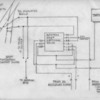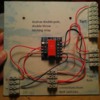While searching for a way to achieve non-derailing with a tortoise switch, I came across the attached design. It was featured in a newsletter posted by North Atlanta O Gauge Railroad Club in 2011. I was curious if anyone has tried it? I tried testing this, but I’ve had no luck making it work. I think I’m following the diagram correctly, with the exception of the LED depicted. I'm sure it works and it's something I'm doing wrong.
Thanks
Chris









